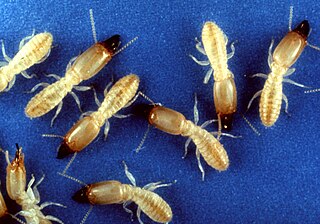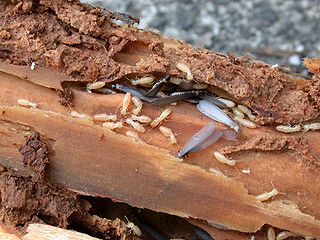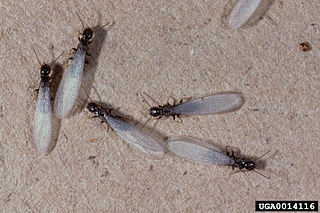
Termites are a group of detritophagous eusocial insects which consume a wide variety of decaying plant material, generally in the form of wood, leaf litter, and soil humus. They are distinguished by their moniliform antennae and the soft-bodied and typically unpigmented worker caste for which they have been commonly termed "white ants"; however, they are not ants, to which they are distantly related. About 2,972 extant species are currently described, 2,105 of which are members of the family Termitidae.

Reticulitermes flavipes, the eastern subterranean termite, is the most common termite found in North America. These termites are the most economically important wood destroying insects in the United States and are classified as pests. They feed on cellulose material such as the structural wood in buildings, wooden fixtures, paper, books, and cotton. A mature colony can range from 20,000 workers to as high as 5 million workers and the primary queen of the colony lays 5,000 to 10,000 eggs per year to add to this total.

Amitermitinae is a disputed subfamily of "higher termites" now often merged with the subfamily Termitinae and is considered by ITIS as a synonym; it had previously been placed in the family Rhinotermitidae.
The Sentricon Termite Colony Elimination System is a subterranean termite pest control product developed and manufactured by Corteva. It was introduced in 1995 as a termite baiting system and an alternative to liquid termicide soil barriers. It eliminates all members of the termite colony, including those of the Formosan subterranean termite colonies.

Coptotermes gestroi, commonly known as the Asian subterranean termite is a small species of termite that lives underground. Both this species and the Formosan subterranean termite are destructive pests native to Asia, but have spread to other parts of the world including the United States. In Asia, this species is known as the Philippine milk termite.

Parastylotermes is an extinct genus of termite in the Isoptera family Stylotermitidae known from North America, Europe, and India. The genus contains five described species, Parastylotermes calico, Parastylotermes frazieri, Parastylotermes krishnai, Parastylotermes robustus, and Parastylotermes washingtonensis.

Reticulitermes is a termite genus in the family Rhinotermitidae. They are found in most temperate regions on Earth including much of Asia and the Middle East, Western Europe, and all of North America.

Reticulitermes banyulensis is a species of termite of the family Rhinotermitidae found in the Roussillon region in France.
Serritermitidae is a family of termites belonging to the infraorder Isoptera in the order Blattodea. The family includes only a few species, which live in South America.

Coptotermes is a genus of termites in the family Rhinotermitidae. Many of the roughly 71 species are economically destructive pests. The genus is thought to have originated in Southeast Asia. Worker termites from this genus forage underground and move about in roofed tunnels that they build along the surface.
Heterotermes indicola, is a species of subterranean termite of the genus Heterotermes. It is native to tropical India, Pakistan and Sri Lanka but has extended its range into the subtropics and warm temperate areas of the Himalayan foothills to altitudes of about 2,000 m (6,600 ft). It causes damage to timber in buildings and is one of the most destructive termites in urban and agricultural areas in the world. Soldiers are about 4.1-4.9mm long. Extracts of garlic and Calotropis procera are known to have termiticidal effects on H. indicola.

Blattoidea is a superfamily of cockroaches and termites in the order Blattodea. There are about 17 families and more than 4,100 described species in Blattoidea.

Gnathamitermes perplexus, the long-jawed desert termites or tube-building termites, is a species of termite in the family Termitidae. It is found in Central America and North America. The species creates tunnels, with both colony founders and workers transporting sand to excavate tunnels using their mandibles. The species is particularly susceptible to infectious nematodes such as Steinernema riobrave.
Reticulitermes hageni, the light southeastern subterranean termite, is a species of termite in the family Rhinotermitidae. It is found in North America.

Reticulitermes hesperus, the western subterranean termite, is a species of termite in the family Rhinotermitidae. It is found in Central America and North America.

Reticulitermes speratus, the Japanese termite, is a species of subterranean termite found in Japan, North Korea, and South Korea. It eats decayed wood. It is adapted to withstand the cold temperatures of the temperate regions it inhabits.

Reticulitermes virginicus is a species of subterranean termite native to North America, found often in the southern United States. It was described in 1907.
Archeorhinotermes is an extinct genus of termites in the family Archeorhinotermitidae, and is the sole genus of the family. There is one described species in Archeorhinotermes, A. rossi. It was discovered in Burmese amber.

Reticulitermes tibialis, the arid-land subterranean termite, is a species of termite in the family Rhinotermitidae. It is found in the United States, mostly in the western half, occurring in deserts, prairies and other dry locations.
Heterotermes aureus, commonly known as the desert subterranean termite, is a species of termite in the family Rhinotermitidae. It is native to the deserts of North America where the colony has an underground nest.










